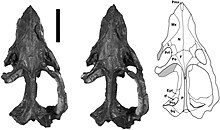| Langbergia Temporal range: Early Triassic, 251–247 Ma PreꞒ Ꞓ O S D C P T J K Pg N ↓ | |
|---|---|

| |
| Figure 2 Stereopair and interpretative drawing of NMQR 3255, holotype of Langbergia modisei, in dorsal view. Ept, epipterygoid; L, lacrimal; Mx, maxilla; N, nasal; F, frontal; P, parietal; Pmx, premaxilla; Po, postorbital; Prf, prefrontal; Pro, prootic; Sq, squamosal; tf, trigeminal foramen (for maxillary and mandibular divisions of the trigeminal nerve). Note that bones in the facial region (maxillae, nasals, lacrimals, and prefrontals) are not in their original position. Shading indicates a broken portion (in the jugal) and sediment posteriorly of the postorbital bar. Scale bar = 3 cm. | |
| Scientific classification | |
| Domain: | Eukaryota |
| Kingdom: | Animalia |
| Phylum: | Chordata |
| Clade: | Synapsida |
| Clade: | Therapsida |
| Clade: | Cynodontia |
| Family: | †Trirachodontidae |
| Subfamily: | †Trirachodontinae |
| Genus: | †Langbergia Abdala et al., 2006 |
| Species | |
| |
Langbergia is an extinct genus of trirachodontid cynodont from the Early Triassic of South Africa. The type and only species L. modisei was named in 2006 after the farm where the holotype was found, Langberg 566. Langbergia was found in the Burgersdorp Formation in the Beaufort Group, a part of the Cynognathus Assemblage Zone. The closely related trirachodontids Trirachodon and Cricodon were found in the same area.
History of discovery
Langbergia was discovered in the Cynognathus Assemblage Zone of the Beaufort Group of South Africa in 2006. It was named after the farm where the holotype was found (Langberg 566).
Description and paleobiology
Trirachodontids are distinguishable due to the shape of their postcanines; the postcanines, distal to the canines, are transversely widened teeth with three main cusps disposed in a transverse row across the center of the tooth. Langbergia are small gomphodontian cynodonts. Cynodonts are a very important component of the Triassic. After the Langbergia fossil was found in 2006, new diagnostic features allowed for a new taxon, Langbergia modisei. Unlike other Trirachodontids, the upper and lower gomphodont post caninines of Langbergia are elliptical in cross section, slightly labiolingually elongated and their long axis is longuomesially orientated. Additionally, both upper and lower lower gomphodont postcanines of Langbergia increase tooth size up until the penultimate tooth and the medial and distal basins are deep and mesiodistally short Trirachodontids Trirachodon and Cricodon have a labial platform of the maxilla that arises lateral to the postcanine series, this is not observed in Langbergia. Langbergia has been recorded having stapes, despite how fragile the structure is.

Langbergia, like most other living in the Permian, went extinct during the end-Permian mass extinction.
Geological information
The Burgersdorp Formation in South Africa is known for having a substantial amount of fossiliferous rocks. The Permo-Triassic strata of the Beaufort Group has a substantial amount of therapsid fossils which are used in the biostratigraphic subdivision. The uppermost division is the Cynognathus Assemblage Zone, this zone covers the late early and early middle Triassic. The Cynognathus Assemblage Zone is then divided into a threefold subdivision. The uppermost subdivision of the Cynognathus Assemblage Zone is named the Lystrosaurus Assemblage Zone. The upper boundary of the Lystrosaurus Assemblage Zone is drawn at the Langbergia and the Garjainia.

References
- ^ Abdala, F.; Neveling, J. & Welman, J. (2006). "A new trirachodontid cynodont from the lower levels of the Burgersdorp Formation (Lower Triassic) of the Beaufort Group, South Africa and the cladistic relationships of Gondwanan gomphodonts". Zoological Journal of the Linnean Society. 147 (3): 383–413. doi:10.1111/j.1096-3642.2006.00224.x.
- Sidor, Christian A.; Hopson, James A. (2017-11-29). "Cricodon metabolus(Cynodontia: Gomphodontia) from the Triassic Ntawere Formation of northeastern Zambia: patterns of tooth replacement and a systematic review of the Trirachodontidae". Journal of Vertebrate Paleontology. 37 (sup1): 39–64. Bibcode:2017JVPal..37S..39S. doi:10.1080/02724634.2017.1410485. ISSN 0272-4634. S2CID 89932366.
- Abdala, Fernando; Ribeiro, Ana Maria (Feb 2010). "Distribution and diversity patterns of Triassic cynodonts (Therapsida, Cynodontia) in Gondwana". Palaeogeography, Palaeoclimatology, Palaeoecology. 286 (3–4): 202–217. Bibcode:2010PPP...286..202A. doi:10.1016/j.palaeo.2010.01.011. ISSN 0031-0182.
- Hendrickx, Christophe (June 2019). "A proposed terminology for the dentition of gomphodont cynodonts and dental morphology in Diademodontidae and Trirachodontidae". PeerJ. 7: e6752. doi:10.7717/peerj.6752. PMC 6571134. PMID 31223521.
- "A new nonmammalian eucynodont (Synapsida, Therapsida) from the Triassic of northern Gansu Province, China, and its biostratigraphic and biogeographic implications. [X25434] Data matrix". MorphoBank datasets. 2020-05-06. doi:10.7934/x25434. S2CID 240818640. Retrieved 2023-03-03.
- Gaetano, Leandro C.; Abdala, Fernando (2015-07-15). "The Stapes of Gomphodont Cynodonts: Insights into the Middle Ear Structure of Non-Mammaliaform Cynodonts". PLOS ONE. 10 (7): e0131174. Bibcode:2015PLoSO..1031174G. doi:10.1371/journal.pone.0131174. ISSN 1932-6203. PMC 4503721. PMID 26176619.
- Day, Michael O.; Rubidge, Bruce S. (2021-02-18). "The Late Capitanian Mass Extinction of Terrestrial Vertebrates in the Karoo Basin of South Africa". Frontiers in Earth Science. 9: 15. Bibcode:2021FrEaS...9...15D. doi:10.3389/feart.2021.631198. ISSN 2296-6463.
- Rayner, Romy R.; Butler, Richard J.; Kammerer, Christian F.; Choiniere, Jonah N. (2022-12-16). "Guttigomphus avilionis gen. et sp. nov., a trirachodontid cynodont from the upper Cynognathus Assemblage Zone, Burgersdorp Formation of South Africa". PeerJ. 10: e14355. doi:10.7717/peerj.14355. ISSN 2167-8359. PMC 9762250. PMID 36545384.
- Hancox, P.J.; Neveling, J.; Rubidge, B.S. (2020-06-01). "Biostratigraphy of the Cynognathus Assemblage Zone (Beaufort Group, Karoo Supergroup), South Africa". South African Journal of Geology. 123 (2): 217–238. Bibcode:2020SAJG..123..217H. doi:10.25131/sajg.123.0016. ISSN 1996-8590. S2CID 225828531.
- "Biostratigraphy of the Lystrosaurus declivis Assemblage Zone (Beaufort Group, Karoo Supergroup), South Africa". pubs.geoscienceworld.org. Retrieved 2023-03-03.
| Cynognathia | ||||||||||||||||||||||||||
|---|---|---|---|---|---|---|---|---|---|---|---|---|---|---|---|---|---|---|---|---|---|---|---|---|---|---|
| ||||||||||||||||||||||||||
| ||||||||||||||||||||||||||
| Taxon identifiers | |
|---|---|
| Langbergia | |

